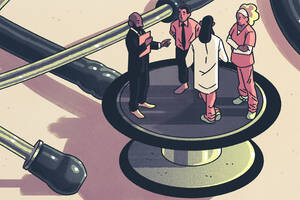You know the drill: dial a customer service number and prepare to wait as the automated message begins: “We are currently assisting other customers. Your call will be answered in the order it was received.” Recorded delay announcements such as these are nothing new, but their strategic use is proving to be a surprisingly complex game played between customers and service providers.
Gad Allon, Achal Bassamboo (Associate Professors of Managerial Economics and Decision Sciences at the Kellogg School of Management), and Itai Gurvich (Assistant Professor of Managerial Economics and Decision Sciences at the Kellogg School of Management) are interested in how delay announcements can be used most efficiently at both ends of the phone line—by service providers and customers alike. Their theoretical research shows that strategic use of wait messages can ultimately improve firm profits and utility to customers.
A Game Played By All
The usefulness and efficiency of providing delay notifications in customer service phone systems depends on a number of factors, including the setup of the queuing system and the motivations and behavior of customers who encounter it. “Sometimes you call with an urgent issue; sometimes you call just to check your balance,” says Allon.
A crucial element of this game is the amount of information that firms provide in the delay announcements they play for customers who call in. Some give no indication of the queue length or wait time. Others may fully disclose the congestion level with a message such as “You are seventh in line to speak to an agent.” Southwest Airlines, for example, tells callers whether they have less than one minute to wait, between seven and ten minutes, or more than ten minutes. Continental Airlines either provides no information or says that the wait time is between five and ten minutes.
The information given in delay notifications is inherently cheap talk—it costs the firm little to provide, it is non-binding, and the customer has no way to verify it. “I cannot name the firm, but if you called them and you were between the first and tenth in line, they would tell you that you were the first in line,” says Allon. “Between eleven in the line and twenty in the line they will tell you that you are second in the line, and so on.”
Additionally, announcements such as “We are experiencing a high volume of calls” provide only vague information. When encountering these kinds of messages, “How should the customer interpret it?” asks Bassamboo. “Is it just babbling or is there any information content there?”
The Customer Is Not Always Naïve
Allon and his colleagues set out to create a model in which both firms and customers behave strategically: firms, in their choice of announcement, and customers, in their decision of whether or not to join the queue. The researchers mathematically modeled the interactions between theoretical customers and service providers and pinpointed the conditions under which predictable outcomes will arise. In their model, both parties are assumed to be self-interested; their interests may or may not align. They also assume that the service is beneficial for customers, while waiting is detrimental.
Allon and his colleagues are not the first to study delay announcements, but their model is the first that does not assume customer naïveté. Previous models have only included customers who believe everything they are told in automated messages. This model is more realistic—as in real life, customers can approach messages with some amount of skepticism and interpret what service providers mean when they deliver vague messages. For example, “first in line” may consistently correspond to a five-minute wait.
As it turns out, things are often predictable in the delay announcement game. Under many conditions, a simple congestion threshold emerged from the researchers’ model. Below it, the firms advise customers to wait by announcing that the congestion level is low, and the customers follow the recommendation. Over the threshold, firms nudge customers to join the system at a later time by giving a high-congestion advisory. Customers follow suit and avoid wasting their time waiting.
The information provided by the firm is simple—with only two signals to indicate high or low congestion—and the customer cannot verify its accuracy; nevertheless, the equilibrium that emerges tends to improve firm profit and customer utility.
In a two-signal scenario, customer behavior—joining the queue or hanging up—identifies those who are most needy, and the limited customer service resources end up going to them. “The people who should stay would stay, the people who should balk will balk, so the firm can actually maximize its own profit or minimize its total cost,” says Bassamboo.
But in the area between full disclosure and complete nondisclosure lies what Allon and his co-authors describe as intentional vagueness. In this case, a firm provides some information, often just enough to entice the customer to stay on the line in the case of misaligned interests—that is, when it may not be in the customer’s best interest, but the firm stands to benefit. “The firm should always try to retain some level of, we call it vagueness, but you can say ambiguity about the real state of the system,” says Allon.
From Equations to Call Centers
Allon and his colleagues found that their predicted two-signal system matches the delay notifications that are already in place for many firms, such as the airline examples cited earlier. The researchers have also begun empirical studies of call center data to complement their theoretical work. Additionally, their model may be applicable to other types of customer service systems, although Allon cautions that high and low congestion announcements do not translate directly to messages provided in online shopping to indicate high or low supply levels, such as “Buy now! Only three left in stock!”
What is the take-home message for service providers? Many firms already employ delay announcements, but modeling how they affect customers could be a way to improve profits without resorting to pricing tools. Firms should use consistent language and tell the truth, say the researchers—it is good for customers and profits. But when it comes to the whole truth and nothing but the truth? Maybe try some intentional vagueness instead.


